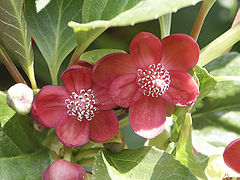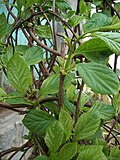Schisandra: Difference between revisions
Jump to navigation
Jump to search
No edit summary |
No edit summary |
||
| Line 2: | Line 2: | ||
|familia=Schisandraceae | |familia=Schisandraceae | ||
|genus=Schisandra | |genus=Schisandra | ||
|habit=vine-climber | |||
|lifespan=perennial | |||
|Temp Metric=°F | |Temp Metric=°F | ||
|jumpin=If this plant info box on watering; zones; height; etc. is mostly empty you can click on the edit tab and fill in the blanks! | |jumpin=If this plant info box on watering; zones; height; etc. is mostly empty you can click on the edit tab and fill in the blanks! | ||
|image= | |image=Schisandra rubriflora.jpg | ||
|image_width=240 | |image_width=240 | ||
|image_caption=Schisandra rubriflora | |||
}} | }} | ||
'''''Schisandra''''' (Magnolia Vine) is a genus of [[shrub]] commonly grown in gardens. It is a hardy [[deciduous]] [[climbing plant|climber]] which thrives in virtually any [[soil]]; its preferred position is on a sheltered shady wall. | |||
It is native to [[East Asia]], and its dried [[fruit]] is used medicinally. | |||
==Cultivation== | |||
'''''Schisandra''''' (Magnolia Vine) is a genus of [[shrub]] commonly grown in gardens. It is a hardy [[deciduous]] [[climbing plant|climber]] which thrives in virtually any [[soil]]; its preferred position is on a sheltered shady wall. It | |||
===Propagation=== | |||
It may be [[plant propagation|propagated]] by taking [[cutting]]s of half-matured [[shoot]]s in August. | |||
===Pests and diseases=== | |||
==Species== | |||
Species include: | |||
*''[[Schisandra chinensis|S. chinensis]]'' | |||
*''[[Schisandra glaucescens|S. glaucescens]]'' | |||
*''[[Schisandra rubriflora|S. rubriflora]]'' | |||
*''[[Schisandra rubrifolia|S. rubrifolia]]'' | |||
*''[[Schisandra sphenanthera|S. sphenanthera]]''. | |||
==Gallery== | |||
<gallery perrow=5> | |||
File:Schisandra.jpg | |||
File:Schisandra chinensis 2.jpg | |||
File:Schisandra chinensis Blüte.jpg | |||
File:Schisandra chinensis (Leaves and buds).JPG | |||
</gallery> | |||
==References== | ==References== | ||
<references/> | <references/> | ||
*[[Standard Cyclopedia of Horticulture]], by L. H. Bailey, MacMillan Co., 1963 | |||
<!--- xxxxx *Flora: The Gardener's Bible, by Sean Hogan. Global Book Publishing, 2003. ISBN 0881925381 --> | |||
<!--- xxxxx *American Horticultural Society: A-Z Encyclopedia of Garden Plants, by Christopher Brickell, Judith D. Zuk. 1996. ISBN 0789419432 --> | |||
<!--- xxxxx *Sunset National Garden Book. Sunset Books, Inc., 1997. ISBN 0376038608 --> | |||
==External links== | |||
*{{wplink}} | |||
{{ | {{stub}} | ||
__NOTOC__ | |||
Latest revision as of 15:46, 21 May 2010
| Schisandra subsp. var. | ||||||||||||||||||||||||||||||||||||||||||||||||||||||||
|---|---|---|---|---|---|---|---|---|---|---|---|---|---|---|---|---|---|---|---|---|---|---|---|---|---|---|---|---|---|---|---|---|---|---|---|---|---|---|---|---|---|---|---|---|---|---|---|---|---|---|---|---|---|---|---|---|

|
|
| ||||||||||||||||||||||||||||||||||||||||||||||||||||||
| ||||||||||||||||||||||||||||||||||||||||||||||||||||||||
Schisandra (Magnolia Vine) is a genus of shrub commonly grown in gardens. It is a hardy deciduous climber which thrives in virtually any soil; its preferred position is on a sheltered shady wall.
It is native to East Asia, and its dried fruit is used medicinally.
Cultivation
Propagation
It may be propagated by taking cuttings of half-matured shoots in August.
Pests and diseases
Species
Species include:
Gallery
References
- Standard Cyclopedia of Horticulture, by L. H. Bailey, MacMillan Co., 1963
External links
- w:Schisandra. Some of the material on this page may be from Wikipedia, under the Creative Commons license.
- Schisandra QR Code (Size 50, 100, 200, 500)



